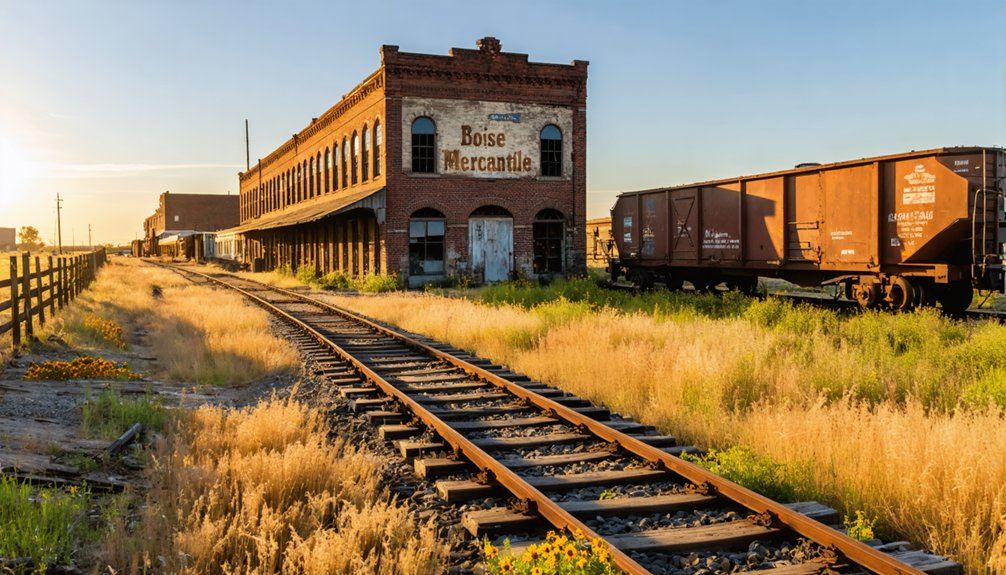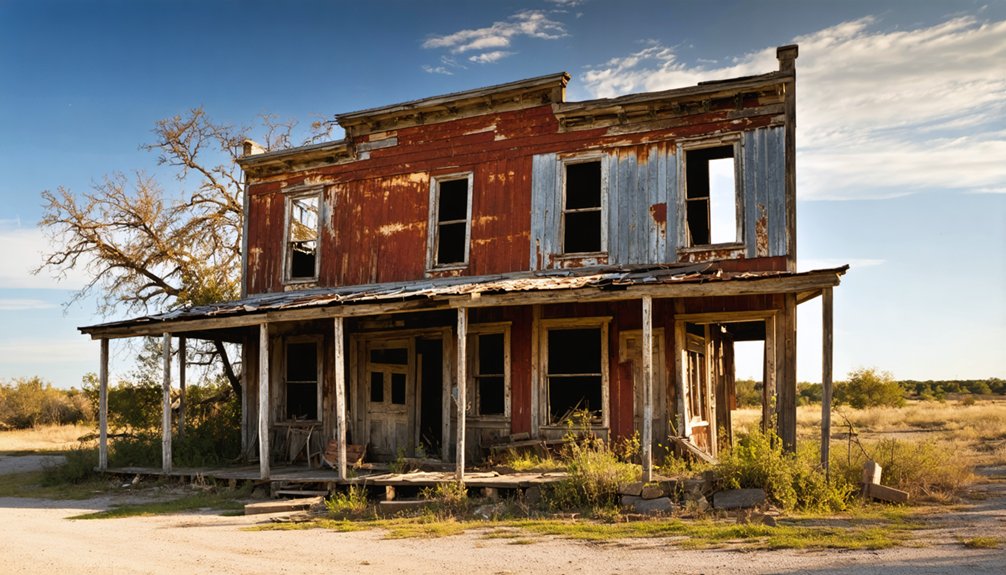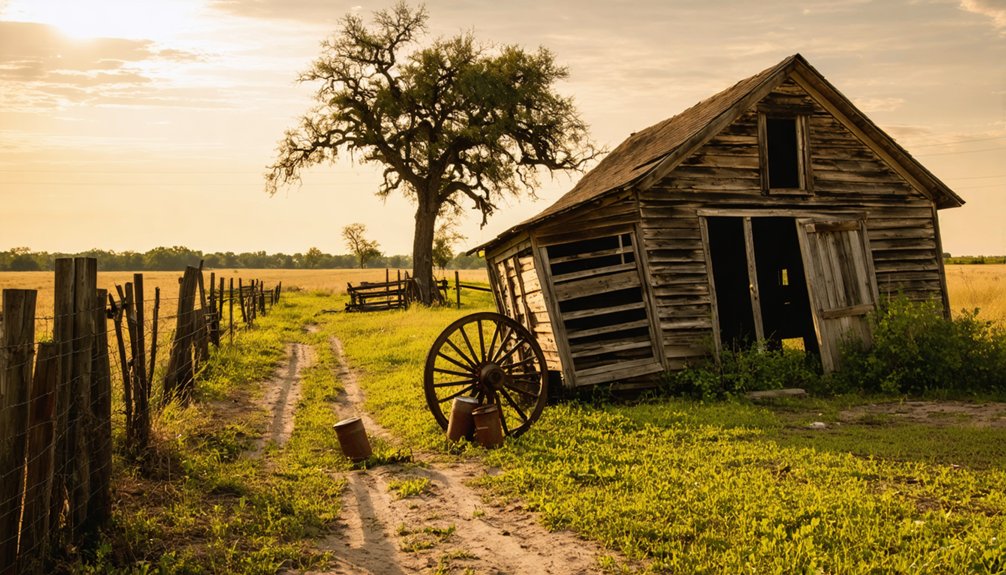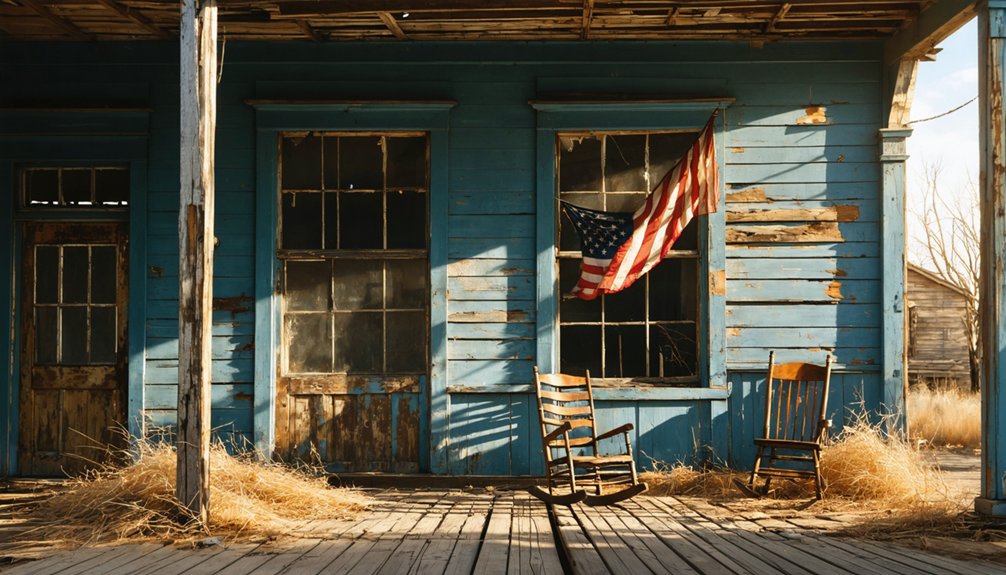You’ll find Boise, Texas’s ghost town origins in a 1908 fraudulent land scheme that landed two promoters in federal prison. The town later thrived as a Chicago, Rock Island and Pacific Railroad hub, serving ranchers and farmers across the Texas Panhandle. After the railroad ended services in the 1980s, Boise’s population dwindled as businesses couldn’t survive without rail connectivity. Today, deteriorating historical structures and unpaved roads tell a fascinating tale of boom-and-bust in Texas history.
Key Takeaways
- Founded in 1908 through a fraudulent land scheme that led to federal imprisonment of two promoters.
- Served as a vital railroad hub along the Chicago, Rock Island and Pacific Railroad line for agricultural shipping.
- Declined rapidly after the Rock Island Railroad ended services in the 1980s, causing population exodus.
- Currently accessible via unpaved roads, featuring deteriorating historical structures with minimal amenities for visitors.
- Originally supported Indigenous communities for 14,000 years before becoming a railroad town and eventual ghost town.
The Rise of a Railroad Town
Although Boise City began as a fraudulent land scheme in 1908, it evolved into a significant railroad hub in Oklahoma’s Panhandle region.
You’d have found that three men – Stanley, Kline, and Douglas – initially promoted the town with false promises of paved streets and artesian wells, landing two of them in federal prison.
Their misleading brochures featured nonexistent trees and rivers to entice potential buyers into purchasing the three thousand available lots.
The Chicago, Rock Island & Pacific Railroad later built 72 miles of track from Guymon to Dalhart, establishing a vital transportation corridor through the region.
Life Along the Texas Panhandle
Before European settlers established their ranches in the Texas Panhandle, this vast region supported thriving Indigenous communities for over 14,000 years.
You’d have found prehistoric settlements of Plains villagers who built stone structures along rivers like the Canadian, crafting distinctive cordmarked pottery and developing complex trade networks. These communities engaged in bison hunting and horticulture as their main food sources.
Life changed dramatically when European expansion pushed into the region. You’ll recognize how the Comanche and Kiowa dominated the area until the late 19th century, when cattle ranchers moved in after buffalo herds were depleted. Anglo buffalo hunters began operating in the region in 1874, leading to significant changes in the territory’s control.
The arrival of Europeans forever altered the Plains, displacing the Comanche and Kiowa after decimating the buffalo they depended upon.
These newcomers, including Charles Goodnight’s JA Ranch, established informal boundaries around water sources.
Transportation Hub and Commerce

When the Chicago, Rock Island and Pacific Railroad established its line through Boise, the town emerged as an indispensable transportation hub for the Texas Panhandle region.
You’d find local ranchers and farmers using the depot to ship their livestock and agricultural products to broader markets, making Boise a critical commercial center. Similar to the infamous Jericho Gap section of Route 66, the area played a crucial role in regional transportation history. Like its namesake in Idaho, the town experienced a dramatic population decline from its peak years.
The transportation evolution proved harsh for Boise’s future. While the railroad initially fueled the town’s growth, the 1980s brought dramatic change when Rock Island Railroad ended its Panhandle services.
This led to a swift commercial decline, disconnecting local producers from essential supply chains. Though Interstate 40 ran nearby, it couldn’t replace the railroad’s importance to Boise’s economy.
Without its rail lifeline, the town gradually lost its commercial significance, leading to its eventual ghost town status.
Agricultural Legacy and Ranching Days
The agricultural story of Boise began alongside its railroad development, as the town served ranchers and farmers throughout the Texas Panhandle. The area’s agricultural practices centered on wheat, corn, and cotton farming, while extensive cattle operations dominated the wide-open grasslands.
You’ll find that Boise’s ranching heritage was characterized by:
- Large, spread-out ranches focusing on beef cattle suited for dryland pasture
- Traditional seasonal roundups and cattle drives to railroad shipping points
- Mixed farming operations combining crops and livestock
- Strategic positioning as a crucial livestock shipping hub
The community thrived on agricultural cycles, with families settling near the depot for convenient access to markets. With a population under 2,000 spread across vast farmlands, the area maintained its rural character throughout its inhabited years. Like many towns during westward expansion, Boise emerged between 1880 and 1940 as settlers moved into the region.
However, environmental challenges, including periodic droughts and the devastating Dust Bowl of the 1930s, combined with changing market dynamics, eventually led to the town’s decline.
The Rock Island Railroad Era
During Rock Island Railroad’s expansion into Texas, a crucial chapter began in 1906 as the company acquired 50% stake in the Trinity and Brazos Valley Railway, establishing essential access to Houston and Galveston markets.
Rock Island’s strategic acquisition of Trinity and Brazos Valley Railway opened vital trading corridors to Texas’s major coastal ports.
You’ll find that Rock Island’s ambitious railroad expansion intensified in the late 1920s, particularly in the Texas Panhandle. They launched construction near Amarillo in 1927, pushing north-northeast toward Liberal, Kansas, while tackling the challenging Canadian River crossing.
The railway’s strategic growth accelerated in 1930 when crews worked simultaneously from Stratford southward, spawning new towns like Etter and Kerrick along their routes. The Sam Houston Zephyr became Texas’s first streamlined passenger service in 1936, marking a significant advancement in regional transportation.
This economic transformation reshaped the Boise area, despite Rock Island’s broader financial struggles. The railroad provided crucial transportation links for agricultural products, connecting local farmers and ranchers to expansive market opportunities beyond Texas. The company’s impressive fleet of 609 diesel units demonstrated its significant operational capacity throughout the region.
Abandonment and Decline
You’ll find that Boise’s decline closely followed the Rock Island Railroad’s cessation of operations through the settlement in the mid-20th century.
As rail service ended, the town’s population began a steady exodus, with families seeking opportunities in larger towns and cities where jobs were more plentiful.
The loss of rail connectivity proved decisive for Boise’s fate, as the remaining businesses couldn’t sustain themselves without the commercial lifeline the railroad had provided, leading to their eventual closure and abandonment.
Railroad Operations Ceased
As financial pressures mounted on railroad companies across Texas in the mid-20th century, Boise’s rail infrastructure fell victim to widespread abandonments.
The railroad nostalgia you’ll find today reflects the economic shifts that transformed this once-bustling rail stop.
- Rock Island Railroad’s failed merger with Union Pacific in the early 1970s accelerated local track closures.
- The line connecting Boise to Panhandle City and Washburn was abandoned when newer routes made it obsolete.
- Tower 48 at Yarnall shut down as part of the systematic dismantling of rail infrastructure.
- Competition from trucking and highways sealed the fate of Boise’s railroad operations.
You’ll find remnants of this vanished era in abandoned depots and overgrown tracks, evidence of the profound changes that reshaped rural Texas transportation networks.
Population Exodus Timeline
The steady depopulation of Boise began with the town’s early identity as a shipping hub along the Chicago, Rock Island and Pacific Railroad.
While you’d have found a bustling community centered around the depot in the early to mid-20th century, population trends show a gradual decline as railroad importance diminished.
Traces of Former Glory

You’ll find Boise’s most prominent remaining structure, the railroad depot, standing as a silent reminder of the town’s role in Texas Panhandle commerce.
The town’s wooden buildings have largely succumbed to time and weather, leaving only scattered ruins and deteriorating foundations across the landscape.
The historic cattle loading platforms, though weathered, still mark where local ranchers once brought their livestock for transport along the Chicago, Rock Island and Pacific Railroad line.
Railroad Depot Remains Standing
Standing proudly on its hilltop perch, Boise’s historic train depot remains one of the city’s most striking landmarks, showcasing its original 1925 Spanish Mission-style architecture and distinctive 96-foot Campanile bell tower.
The depot’s remarkable features include:
- Stucco walls and asymmetrical wings designed by renowned New York architects Carrère and Hastings
- Spanish trusses adorned with decorative railroad motifs
- Arched entrances with extensive glass windows
- Strategic alignment with the Idaho State Capitol dome
A $3.4 million renovation in 1993 restored the depot to its former glory, preserving its historical integrity while adapting it for modern use.
Though the rail lines are gone, you’ll find this architectural masterpiece now serves as a venue for community gatherings, managed by Boise Parks and Recreation Department.
Lost Town’s Wooden Structures
Scattered throughout Boise’s ghost town landscape, weathered wooden structures tell stories of its frontier past, with several late 19th and early 20th-century buildings still partially intact.
You’ll find wooden houses showcasing craftsmanship through hand-cut lumber and naive joinery, their gable roofs and window frames defying time.
The town’s commercial buildings, with their distinctive false-front facades, stand as bold reminders of frontier entrepreneurship.
These former general stores and saloons feature raised wooden floors and surviving shelving that hint at bustling trade.
Around these structures, you’ll spot remnants of wooden fencing, corrals, and outbuildings that once served daily life.
Simple wooden infrastructure, from elevated boardwalks to bridge fragments, maps out the ghost town’s original layout, though nature steadily reclaims these weathered remains.
Historic Cattle Loading Platforms
The rugged cattle loading platforms of Boise stand as silent monuments to Texas’s golden age of cattle shipping. These elevated structures revolutionized the cattle economy by connecting overland drives to the expanding railroad network, transforming how ranchers moved their herds to distant markets.
You’ll find these critical shipping logistics hubs were masterfully engineered with:
- Stone and treated timber construction for maximum durability
- Elevated ramps allowing direct access to stock cars
- Integrated chutes for safe, efficient cattle movement
- Sorting areas for brand verification and health inspections
As you explore Boise’s platforms today, you’re witnessing the change point where traditional cattle drives met industrial-age transportation.
While trucks and refrigerated rail cars eventually made these structures obsolete, they represent a pivotal era when Texas ranching embraced modernization.
Historical Significance in Oldham County

While many Texas ghost towns have faded into obscurity, Boise’s historical significance in Oldham County stems from its role as an essential railroad shipping point along the Chicago, Rock Island and Pacific line.
You’ll find its cultural heritage deeply rooted in the Texas Panhandle’s agricultural traditions, serving local ranchers and farmers at an elevation of 4,003 feet.
Boise’s story reflects the economic change that swept through rural Texas communities in the late 20th century. When the Rock Island railroad discontinued service in the 1980s, the town’s critical role as a transportation hub diminished.
Like many similar communities bypassed by modern highways, Boise evolved from a thriving rural center to a ghost town, preserving a snapshot of Oldham County’s railroad era and ranching legacy.
Ghost Town Tourism Today
You’ll find Boise’s ghost town remains accessible via unpaved roads, though visitors should check local conditions before traveling due to limited infrastructure and seasonal weather impacts.
The site features several deteriorating historical structures, including building foundations and remnants that reflect the town’s past, though safety concerns require cautious exploration.
While on-site amenities are minimal, you can find basic services and accommodations in neighboring communities, making Boise best suited for day trips as part of broader regional tourism itineraries.
Accessing The Ghost Town
Located twenty miles west of Adrian in southwestern Oldham County, accessing Boise’s ghost town remains requires careful planning and respect for private property.
For rural tourism enthusiasts interested in ghost town exploration, you’ll need to navigate local roads south of Interstate 40, keeping in mind that much of the surrounding area consists of private ranch lands.
Key considerations for accessing Boise:
- No visitor facilities or guided tours are available
- Most visible structures belong to private properties
- Photography is limited to public roadways only
- You’ll need to be self-sufficient as no amenities exist nearby
Unlike more developed ghost towns like Terlingua, Boise offers minimal visible remnants of its past.
The former Chicago, Rock Island and Pacific Railroad line that once served the town ceased operations in the 1980s, further limiting access options.
Historical Sites Still Standing
Despite Boise’s limited accessibility, several remarkable historical structures remain standing today as silent witnesses to the town’s past.
You’ll find classic examples of historic architecture in the weathered church building and vintage service station, both showcasing early 20th-century construction methods.
The town’s cemetery stands as one of the most intact sites, preserving the community legacy through its period gravestones and burial records.
While most original buildings have fallen into neglect, leaving only roofless ruins, some abandoned commercial structures offer glimpses into the town’s former liveliness.
Route 66-era remnants, including the old Magnolia Service Station, represent Boise’s connection to America’s historic highway culture.
These surviving structures now serve as focal points for photographers and history enthusiasts exploring Texas ghost towns.
Nearby Tourist Amenities
Modern travelers to Boise ghost town will find limited tourist infrastructure in the surrounding area. You’ll need to plan ahead for accommodations, as the nearest lodging options are 30-50 miles away, with rates starting at $89 during off-peak seasons.
Local dining consists mainly of small diners serving Texan cuisine, while cultural attractions and recreational activities have diminished due to regional tourism decline.
For your visit, expect:
- Basic motels and B&Bs rather than chain hotels
- Informal parking areas with no dedicated visitor centers
- Self-guided exploration opportunities, as formal tours are limited
- Seasonal outdoor activities like hiking and bird-watching
Access is primarily by private vehicle, and you’ll want to verify road conditions before traveling.
While some informal guide services remain, most tourist amenities operate on reduced schedules with minimal modern conveniences.
Preserving the Memory
As digital technology advances, preservation efforts for Boise and other ghost towns have evolved beyond physical conservation to include extensive digital archiving initiatives.
You’ll find that memory preservation now integrates historical photographs, maps, and oral histories into accessible online platforms, allowing you to explore these vanished communities from anywhere.
Community engagement plays an essential role in keeping Boise’s history alive through partnerships with local historical societies and preservation groups.
You can participate in volunteer programs and educational outreach initiatives that help document the town’s geographical data, elevation, and historical context.
The U.S. Army Corps of Engineers and organizations like the National Endowment for the Humanities provide significant support through grants and technical assistance, ensuring that Boise’s story remains part of Texas’s rich cultural heritage for future generations to discover.
Frequently Asked Questions
Was Boise, Texas Named After Boise, Idaho?
You can’t definitively determine if Boise, Texas’s origins drew its name from Boise, Idaho. Historical records don’t confirm any name significance linking the two cities, despite sharing identical names.
What Natural Disasters, if Any, Contributed to Boise’s Abandonment?
You won’t find evidence of specific natural disasters causing Boise’s abandonment. Instead, economic decline from being bypassed by railroads and challenging environmental conditions gradually led to the town’s demise.
Are There Any Remaining Structures Still Standing in Boise Today?
Through overgrown brush and crumbling earth, you’ll find only foundational ruins and weathered wall fragments today. No complete remaining buildings of historical significance still stand in this forgotten landscape.
Did Any Famous Historical Figures Ever Visit or Live in Boise?
There’s no historical evidence of famous visitors or documented historical connections to any notable figures in the town. Records don’t indicate any prominent individuals ever residing there or passing through.
What Was the Peak Population of Boise During Its Most Prosperous Years?
Like a fading mirage in the Texas Panhandle, you’ll find no definitive peak population records, but comparing similar ghost towns suggests Boise likely peaked between 50-150 residents before its population decline.
References
- https://mix941kmxj.com/the-strange-sad-story-of-a-texas-ghost-town-youll-never-visit/
- https://fromboise.com/posts/the-other-boises
- https://en.wikipedia.org/wiki/Boise
- https://www.geotab.com/ghost-towns/
- https://en.wikipedia.org/wiki/List_of_ghost_towns_in_Texas
- https://www.allacrosstexas.com/texas-ghost-town.php?city=Boise
- https://www.texasescapes.com/TexasGhostTowns/Boise-Texas.htm
- https://kids.kiddle.co/Boise
- https://www.worldatlas.com/cities/you-won-t-believe-this-town-is-in-oklahoma.html
- http://txrrhistory.com/towers/172/172.htm



